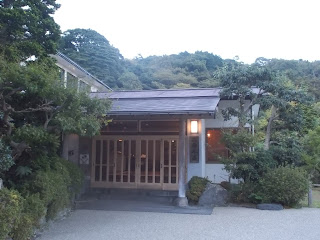After walking around the spa town of
Kannawa, we headed to Okamotoya Ryokan (岡本屋旅館), a Japanese-style inn in Myoban Onsen. I once stayed about 30 years ago when I was an elementary school student. I went there on a family trip, I enjoyed their food very much.
This time we just stay for one night and booked on the ryokan site at a reasonable cost, 19,800 yen per person per night with two meals. We couldn't pay by card but the staff are friendly.
The room we stayed at Botan (牡丹). Botan means peony in Japanese. It has six tatami mats with a balcony.
A nice view of the Beppu city in the evening from a room.
Menu list for dinner.
Appetizer. We had five different types of food; Tofu, Castella (=a Portuguese word for sponge cake), Roasted duck, Simmered shimeji mushroom with chrysanthemum leaves and Sliced lotus root. We got a Kabosu wine for aperitif. By the way, Kabosu is local specialties in Oita Prefecture.
A bowl of rice served with miso soup. Oh there's delicious
Sashimi food too.
Fish hot pot with some veggies.
Steamed chicken and vegetables before main dish. Don't forget to eat with miso sauce!
When it's done, they bring up the main menu.
Deep fried shrimp with sweet potato soup.
The original steamed pudding for dessert.
The night view of Beppu from my bed room is beautiful.
To be continued..

















































